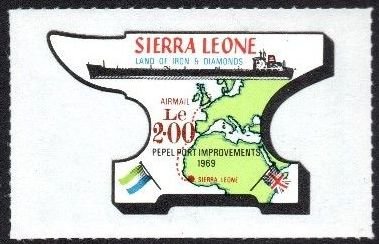Stamp: Map (Sierra Leone 1969)
Map (Sierra Leone 1969)
10 July (Sierra Leone ) within release Completion of the Pepel Port iron ore carrier terminal goes into circulation Stamp Map face value 2 Sierra Leonean leone
| Stamp Map in catalogues | |
|---|---|
| Michel: | Mi: SL 460 |
| Stamp Number: | Sn: SL C95 |
Stamp is square format.
Also in the issue Completion of the Pepel Port iron ore carrier terminal:
- Stamp - Map face value 10;
- Stamp - Map face value 50;
- Stamp - Map face value 2;
- Stamp - Map face value 3½;
- Stamp - Globe face value 7½;
- Stamp - Map face value 2;
- Stamp - Globe face value 15;
- Stamp - Map face value 1;
- Stamp - Map face value 9½;
- Stamp - Map face value 25;
- Stamp - Map face value 18½;
- Stamp - Globe face value 1;
|
Data entry completed
53%
|
|
|---|---|
| Stamp Map in digits | |
| Country: | Sierra Leone |
| Date: | 1969-07-10 |
| Print: | Offset lithography |
| Perforation: | Die Cut |
| Emission: | Air Post |
| Format: | Stamp |
| Face Value: | 2 Sierra Leonean leone |
Stamp Map it reflects the thematic directions:
A flag is a piece of fabric (most often rectangular or quadrilateral) with a distinctive design that is used as a symbol, as a signaling device, or as decoration. The term flag is also used to refer to the graphic design employed, and flags have since evolved into a general tool for rudimentary signalling and identification, especially in environments where communication is similarly challenging (such as the maritime environment where semaphore is used). National flags are patriotic symbols with varied wide-ranging interpretations, often including strong military associations due to their original and ongoing military uses. Flags are also used in messaging, advertising, or for other decorative purposes. The study of flags is known as vexillology, from the Latin word vexillum, meaning flag or banner.
A map is a symbolic depiction emphasizing relationships between elements of some space, such as objects, regions, or themes. Many maps are static, fixed to paper or some other durable medium, while others are dynamic or interactive. Although most commonly used to depict geography, maps may represent any space, real or imagined, without regard to context or scale, such as in brain mapping, DNA mapping, or computer network topology mapping. The space being mapped may be two dimensional, such as the surface of the earth, three dimensional, such as the interior of the earth, or even more abstract spaces of any dimension, such as arise in modeling phenomena having many independent variables. Although the earliest maps known are of the heavens, geographic maps of territory have a very long tradition and exist from ancient times. The word "map" comes from the medieval Latin Mappa mundi, wherein mappa meant napkin or cloth and mundi the world. Thus, "map" became the shortened term referring to a two-dimensional representation of the surface of the world.
A ship is a large watercraft that travels the world's oceans and other sufficiently deep waterways, carrying passengers or goods, or in support of specialized missions, such as defense, research and fishing. Historically, a "ship" was a sailing vessel with at least three square-rigged masts and a full bowsprit. Ships are generally distinguished from boats, based on size, shape and load capacity.



